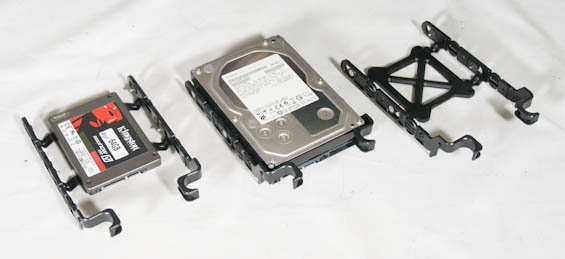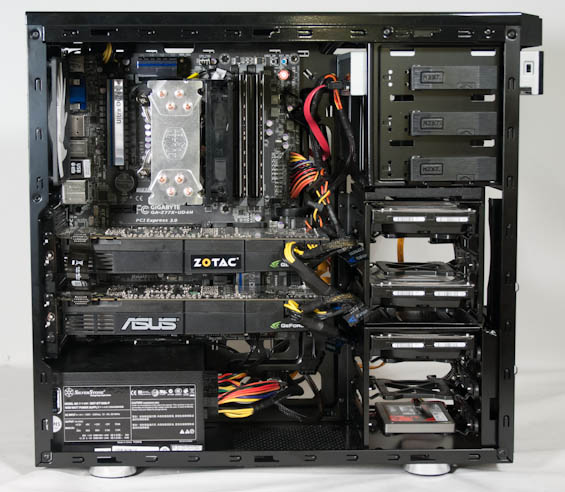NZXT H230 Silent Case Review
by Dustin Sklavos on September 13, 2013 12:00 PM EST- Posted in
- Cases/Cooling/PSUs
- NZXT
- ATX
- Case
My last few building experiences with NZXT cases have for the most part been fairly pleasant, and I was expecting a pretty breezy experience with the H230 as well. I got...most of that breezy experience, but this definitely could've been easier.
I'm assuming in a bid to get the production cost down, the H230 doesn't come with any standoffs or guides installed in the motherboard tray. That's not a tremendous sacrifice given the price segment we're competing in, but it's a small nuisance. Installing the test motherboard was easy enough, but where things went a little bit south was when it came to installing the drives.

The toolless mechanism NZXT uses for the 5.25" drive bays is actually pretty excellent and one of the better ones I've tested, but the 2.5"/3.5" drive trays are pretty terrible. They're incredibly flexible and they don't lock into the drive cages very well. If you install a 3.5" mechanical drive into one, that will stabilize it a little bit, but I found it was easy to make the tray with the 2.5" drive installed in it fall out of the case. This won't be a major problem for a case that's going to spend its life stationary with very little modification, but it's just so...shoddy.

Installing expansion cards and the power supply was very easy, but this is not a case designed for a tremendous amount of hardware. For some time I've felt like that was really the paradox of the ATX case; built to house the ATX board, but not really designed to handle a fully fleshed out system that takes advantage of the ATX spec. The result is that cabling proved to be a nightmare exacerbated heavily by the notched side panels; getting the rear panel back on is an exercise in frustration, as the spacing offered by NZXT isn't particularly generous. Also keep in mind that because the drive sleds enter from the back of the motherboard tray instead of the front, the handles on them can actually impede drive cabling.
I want to cut NZXT some slack for the H230's assembly, but these are issues that BitFenix already resolved a long time ago. The H230's internal design just isn't as progressive as competing cases; space could've been better utilized by bevelling the motherboard tray to allow for better cable channelling, and the drive sleds desperately need to be rethought. I'm also not sure we even needed the center drive cage, which undoubtedly takes away from NZXT's budget for the case design but doesn't seem to offer enough in exchange. If we're talking about a stripped down $69 case, what do we need more than three drive sleds for? If anything, bump the bottom cage up to four and call it a day.


_thumb.jpg)
_thumb.jpg)
_thumb.jpg)
_thumb.jpg)
_thumb.jpg)
_thumb.jpg)








29 Comments
View All Comments
zero2dash - Friday, September 13, 2013 - link
I thought about buying one of these a few days ago but since the only 2 reviews out there for the case are not very flattering, I figured I'd wait for someone more worth their salt to review it.AT delivers as usual; thanks for the review Dustin.
This looks like a silent case built for computers that don't make a lot of noise to begin with....the onboard video, 1 HD, ≤ 430W PSU systems.
Guess I'll continue trying to lower the noise in my Core 3000 instead.
flemeister - Saturday, September 14, 2013 - link
You've got the right idea. =)First deal with the noise making components:
* Fans: fan control, undervolt, or change to better quality or quieter models (eg. for the PSU).
* Hard drives: 5400/5900RPM models to reduce vibration and high-freq. noise compared to 7200RPM models (relying on your SSD for speedy stuff). Also suspension with elastic cord, which can even be done in the internal 3.5" bays if they're wide enough. Or go all SSD. ^_^
That should be a marked improvement. But if you'd like to go further, get an enclosed case with solid panels, solid build quality (eg. Antec Solo, Antec P18x), mass damping and acoustic foam. Ideally, a case with not too restrictive ventilation. Generally though you'll have to sacrifice one of performance, temps or dust filtering to keep the noise down. Only under load though; at idle there should be no problem keeping the rig quiet. Few are so anal as to desire near silence at both idle and load. =)
WarrenSmith - Saturday, September 14, 2013 - link
Love my job, since I've been bringing in $5600… I sit at home, music playing while I work in front of my new iMac that I got now that I'm making it online( Click on menu Home)http://goo.gl/6N9nai
KLC - Friday, September 13, 2013 - link
"the perfect silent chassis for users looking for the bare essentials"Maybe 20 years ago a huge case was required for the bare essentials, but not anymore. With better CPUs that require lower power, with 4tb hard drives that negate the need for multiple hard drives, and with higher power integrated graphics that eliminate the need for GPUs, the bare essentials in 2013 are more like a small mini ITX box than gigantic case the size of microwave.
The PC industry is still living in the past.
et20 - Friday, September 13, 2013 - link
I completely agree.At this point, in any case review I see I immediately check for for factor and ignore everything larger than microATX.
JoanSpark - Monday, September 16, 2013 - link
so true.. where are the reviews of mini-ITX or m-ATX cases?lwatcdr - Saturday, September 14, 2013 - link
For the average home user yes. Even an ITX board would do. Thing is that the average home user buys a PC or these days a notebook or even a tablet.1. Integrated graphics are not good enough for high end CAD, gaming, or video editing.
2. Multiple monitors are becoming the norm for developers and large high resolution monitors are becoming cheap.
3. People do still roll their own NAS boxes so lots of drives is a plus for them.
Bare essentials vary by use case.
For me it would be a good nVidia graphics card, i5 or i7, at least 16gb of ram, one SSD boot and two HDDs in Raid for storage. I like slots because I do some hardware work as well and like to add at least one real serial port.
Grok42 - Saturday, September 14, 2013 - link
Every thing you describe is handled by common mITX systems. I build a mITX system with an Intel i7 3770k, 16GB of ram, Nvidia 660ti and a 840pro SSD. Your need for a real serial port is pretty unusual given that I work for a company that does tons of hardware development and everything has USB interfaces these days even when it's serial over USB.JoanSpark - Monday, September 16, 2013 - link
Zotac H87-ITX... besides the other stuff you need we find.. "internal connectors: .. serial COM port header".Admitted though.. with mATX this would be easier ;-)
Still no need for full blown ATX cases anymore for 90% of the users of such hardware.
Grok42 - Sunday, September 15, 2013 - link
I completely agree. I've noticed a lot more "mini" GPUs coming out lately as well which will make it even easier to build mITX systems. I guess everyone is getting the picture that small cases are the future except the case manufactures.My only complaint with mITX is the PSU. While there are tons of good ones out there and most mITX cases support full ATX or small ATX PSUs, there is a lack of a specific standard for small ATX PSU that makes picking a PSU a case by case decision.